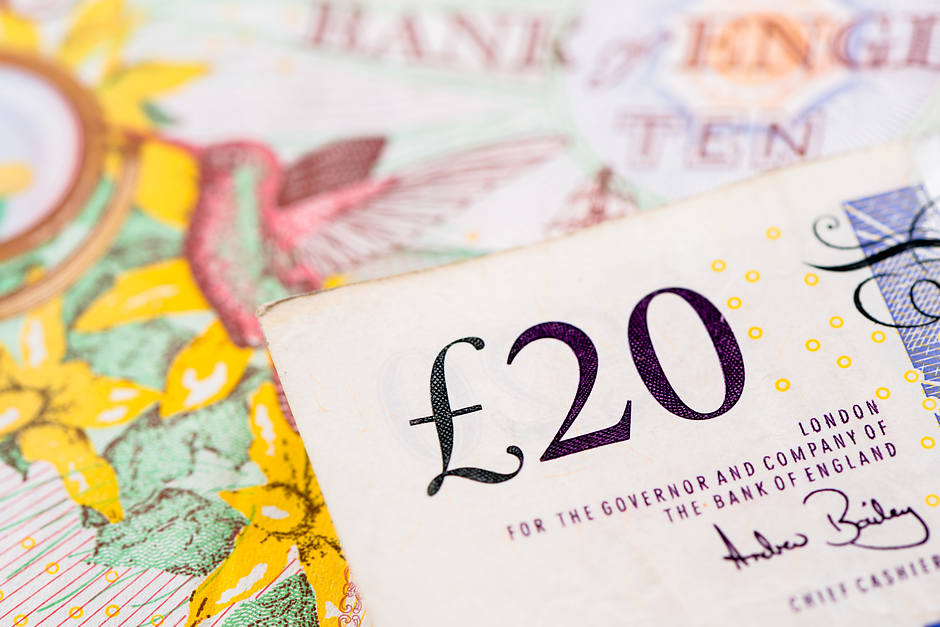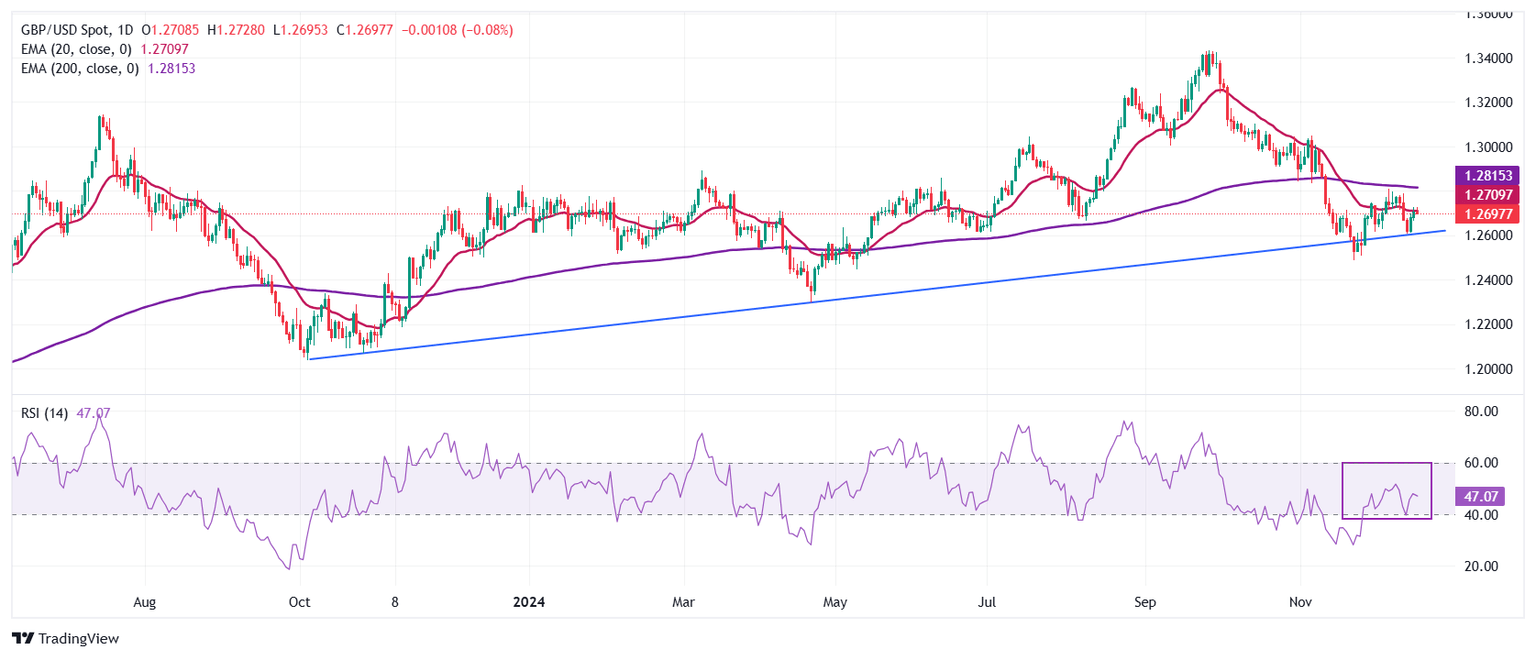Pound Sterling consolidates ahead of Fed-BoE policy announcement
- The Pound Sterling consolidates against the US Dollar ahead of the Fed policy meeting.
- The Fed is expected to cut interest rates by 25 basis points to 4.25%-4.50%.
- An expected rise in the UK inflation data cements prospects that the BoE will keep interest rates steady at 4.75% on Thursday.

The Pound Sterling (GBP) remains broadly sideways against the US Dollar (USD) around 1.2700 in Wednesday’s North American session. The US Dollar consolidates ahead of the Federal Reserve’s (Fed) monetary policy announcement at 19:00 GMT. According to the CME FedWatch tool, traders have priced in a 25-bps interest-rate reduction, which would be the third consecutive interest rate cut.
With market participants expecting a cut, investors will pay close attention to the Federal Open Market Committee (FOMC) Economic Projections and the dot plot, which shows where policymakers see the Federal funds rate heading in the medium and longer term.
According to a recent Bloomberg survey, a majority of economists expect a less dovish Fed in 2025. Economists see the Fed reducing interest rates three times next year as inflation remains above the Fed's target. The survey also indicated that economists have become more worried about upside risks to inflation from incoming President-elect Donald Trump's policies, which include mass deportations, higher import tariffs, and tax cuts.
Daily digest market movers: Pound Sterling didn't react much to expected rise in UK CPI
- The Pound Sterling trades in tight range against its major peers on Wednesday even though the United Kingdom (UK) Consumer Price Index (CPI) data for November showed that price pressures rose in line with estimates. The CPI report highlighted that annual headline inflation accelerated to 2.6% YoY, as expected, from 2.3% in October.
- Compared with the previous month, headline inflation rose by 0.1%, also meeting expectations and easing from the 0.6% growth in October.
- The core CPI – which excludes volatile items such as food, energy, oil, and tobacco – grew by 3.5%, slower than estimates of 3.6% but faster than the former reading of 3.3%. Services inflation, a closely watched indicator by Bank of England (BoE) officials, rose steadily by 5%.
- The rise in inflation cements expectations that the Bank of England (BoE) will leave interest rates unchanged at 4.75% in the policy meeting on Thursday, with an 8-1 vote split. BoE Monetary Policy Committee (MPC) member Swati Dhingra is expected to vote for cutting interest rates by 25 basis points (bps) to 4.5%.
- Investors will closely watch BoE Governor Andrew Bailey’s press conference to gauge whether the central bank will accelerate its policy easing in 2025.
- Going forward, investors will also focus on the UK November retail Sales data, which will be released on Friday.
British Pound PRICE Today
The table below shows the percentage change of the British Pound (GBP) against listed major currencies today. The British Pound was the strongest against the New Zealand Dollar.
| USD | EUR | GBP | JPY | CAD | AUD | NZD | CHF | |
|---|---|---|---|---|---|---|---|---|
| USD | -0.10% | -0.06% | 0.09% | 0.05% | 0.25% | 0.33% | 0.11% | |
| EUR | 0.10% | 0.03% | 0.18% | 0.14% | 0.34% | 0.42% | 0.21% | |
| GBP | 0.06% | -0.03% | 0.12% | 0.11% | 0.32% | 0.40% | 0.17% | |
| JPY | -0.09% | -0.18% | -0.12% | -0.05% | 0.15% | 0.22% | 0.01% | |
| CAD | -0.05% | -0.14% | -0.11% | 0.05% | 0.21% | 0.28% | 0.07% | |
| AUD | -0.25% | -0.34% | -0.32% | -0.15% | -0.21% | 0.07% | -0.14% | |
| NZD | -0.33% | -0.42% | -0.40% | -0.22% | -0.28% | -0.07% | -0.22% | |
| CHF | -0.11% | -0.21% | -0.17% | -0.01% | -0.07% | 0.14% | 0.22% |
The heat map shows percentage changes of major currencies against each other. The base currency is picked from the left column, while the quote currency is picked from the top row. For example, if you pick the British Pound from the left column and move along the horizontal line to the US Dollar, the percentage change displayed in the box will represent GBP (base)/USD (quote).
Technical Analysis: Pound Sterling trades close to 20-day EMA
The Pound Sterling wobbles near the 20-day Exponential Moving Average (EMA) near 1.2815 against the US Dollar (USD). The GBP/USD pair rebounded near the upward-sloping trendline around 1.2600, which is plotted from the October 2023 low at around 1.2035.
The 14-day Relative Strength Index (RSI) oscillates in the 40.00-60.00 range, suggesting a sideways trend.
Looking down, the pair is expected to find a cushion near the psychological support of 1.2500. On the upside, the 200-day EMA near 1.2710 will act as key resistance.
BoE FAQs
The Bank of England (BoE) decides monetary policy for the United Kingdom. Its primary goal is to achieve ‘price stability’, or a steady inflation rate of 2%. Its tool for achieving this is via the adjustment of base lending rates. The BoE sets the rate at which it lends to commercial banks and banks lend to each other, determining the level of interest rates in the economy overall. This also impacts the value of the Pound Sterling (GBP).
When inflation is above the Bank of England’s target it responds by raising interest rates, making it more expensive for people and businesses to access credit. This is positive for the Pound Sterling because higher interest rates make the UK a more attractive place for global investors to park their money. When inflation falls below target, it is a sign economic growth is slowing, and the BoE will consider lowering interest rates to cheapen credit in the hope businesses will borrow to invest in growth-generating projects – a negative for the Pound Sterling.
In extreme situations, the Bank of England can enact a policy called Quantitative Easing (QE). QE is the process by which the BoE substantially increases the flow of credit in a stuck financial system. QE is a last resort policy when lowering interest rates will not achieve the necessary result. The process of QE involves the BoE printing money to buy assets – usually government or AAA-rated corporate bonds – from banks and other financial institutions. QE usually results in a weaker Pound Sterling.
Quantitative tightening (QT) is the reverse of QE, enacted when the economy is strengthening and inflation starts rising. Whilst in QE the Bank of England (BoE) purchases government and corporate bonds from financial institutions to encourage them to lend; in QT, the BoE stops buying more bonds, and stops reinvesting the principal maturing on the bonds it already holds. It is usually positive for the Pound Sterling.
Author

Sagar Dua
FXStreet
Sagar Dua is associated with the financial markets from his college days. Along with pursuing post-graduation in Commerce in 2014, he started his markets training with chart analysis.


















